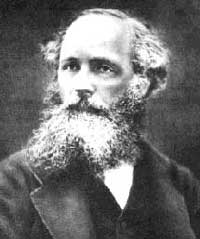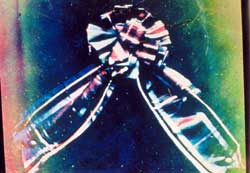James Clerk Maxwell: Difference between revisions
No edit summary |
No edit summary |
||
| Line 21: | Line 21: | ||
Maxwell retired to Glenlair in the mid 1860s and began writing what became the book Electricity and Magnetism (published in 1873). In 1871, rather reluctantly, he accepted an offer to return to Cambridge as their first Cavendish Professor of Physics. In that capacity he edited Henry Cavendish's papers and designed the world famous Cavendish Laboratory. In the spring of 1879 Maxwell’s health began to deteriorate. He and his wife, Katherine, returned to Glenlair. Although suffering from a painful cancer, Maxwell reportedly remained cheerful and calm until his death in November at the age of 48. | Maxwell retired to Glenlair in the mid 1860s and began writing what became the book Electricity and Magnetism (published in 1873). In 1871, rather reluctantly, he accepted an offer to return to Cambridge as their first Cavendish Professor of Physics. In that capacity he edited Henry Cavendish's papers and designed the world famous Cavendish Laboratory. In the spring of 1879 Maxwell’s health began to deteriorate. He and his wife, Katherine, returned to Glenlair. Although suffering from a painful cancer, Maxwell reportedly remained cheerful and calm until his death in November at the age of 48. | ||
=== Further Reading === | In his final days, Maxwell confided in a friend and colleague from Cambridge: | ||
<blockquote> | |||
''What is done by what I call myself is, I feel, done by something greater than myself…I have been thinking how very gently I have always been dealt with. I never had a violent shove in all my life. The only desire which I can have is like David to serve my own generation by the will of God, and then fall asleep.''<br> | |||
</blockquote> | |||
=== Further Reading === | |||
Lewis Campbell, The Life of James Clerk Maxwell, (London, MacMillamn & Co., 1882). | Lewis Campbell, The Life of James Clerk Maxwell, (London, MacMillamn & Co., 1882). | ||
Revision as of 16:41, 30 September 2008
James Clerk Maxwell: Biography
<pageby comments="false" nominor="false"></pageby>;
Born: 13 June 1831
Died: 05 November 1879
James Clerk Maxwell is considered one of the most important physicists of the 19th century and of all time. His
best-known discoveries concern the relationship between electricity and magnetism and are summarized in what has become known as Maxwell’s Equations, which have become a major underpinning of modern physics. In addition to this work Maxwell also made significant contributions in other areas. He did extensive work and research on the kinetic theory of gases, the nature of Saturn’s rings, and the perception of color. The latter interest led to Maxwell’s making what many consider to be the first color photograph in 1861.
Maxwell was born in 1831 and was raised as an only child after a sister died in infancy. Maxwell’s mother died when he was only 8 years old leaving his father to raise him on the family estate of Glenlair, in rural Scotland. Maxwell’s father hired a tutor to educate the boy, but the relationship between teacher and pupil was tense and difficult and marked by harsh treatment. When Maxwell’s father discovered the mistreatment, Maxwell was sent to live with an aunt and began to attend Edinburgh Academy.
Although Maxwell’s tutor had once described his young charge as “slow,” the facts suggest that the slow one in the duo may, in fact, have been the tutor who failed to recognize Maxwell’s brilliance. Maxwell was an intensely curious and talented student. At the age of 14 he made his first contribution to mathematics in the study of oval curves, and actually published a paper on the topic. At age 15 or 16 he was admitted to the University of Edinburgh. In 1850, he transferred to Trinity College, Cambridge University in England and four years later placed second in the difficult Tripos exam. He then received a fellowship to Cambridge, became a tutor himself for a while, and then, in 1856, became a professor at Marischal College in Aberdeen, Scotland. It was at Marischal that Maxwell rekindled an early interest in Saturn’s rings. Using mathematics, not a telescope, he theorized that the rings could not be solid, as was then widely believed. His paper on the subject garnered him the prestigious Adam’s Prize.
Unfortunately, just four years after joining Marischal College, Maxwell lost his professorship due to a reorganization of the faculty. A short time later, however, Maxwell became a professor at King’s College, London and remained there for six years. It was at King’s College that Maxwell performed his most important research. It was there, for example, that Maxwell worked out his “kinetic theory of gases,” which has to do with the motion of atoms in a gas and where he demonstrated color photography. Most importantly however, it was during the 1860s that Maxwell began formulating the equations that are the foundation of electromagnetic theory. This work is considered by many to be one of the greatest intellectual achievements of all time.
Maxwell’s Equations are not the four simple looking equations we use today. Initially Maxwell wrote a set of 20 equations, which were incomprehensible to most of his contemporaries. His ideas were so advanced that very few people understood the importance of what he had done. It wasn’t until a few others such as English physicist Oliver Heaviside took a look at the equations more than a decade later that their importance began to be recognized.
A reproduction of a photograph of a tartan ribbon made from Maxwell’s original 3 color separated prints. Made in 1861, it is widely considered to be the first color photograph.
Maxwell retired to Glenlair in the mid 1860s and began writing what became the book Electricity and Magnetism (published in 1873). In 1871, rather reluctantly, he accepted an offer to return to Cambridge as their first Cavendish Professor of Physics. In that capacity he edited Henry Cavendish's papers and designed the world famous Cavendish Laboratory. In the spring of 1879 Maxwell’s health began to deteriorate. He and his wife, Katherine, returned to Glenlair. Although suffering from a painful cancer, Maxwell reportedly remained cheerful and calm until his death in November at the age of 48.
In his final days, Maxwell confided in a friend and colleague from Cambridge:
What is done by what I call myself is, I feel, done by something greater than myself…I have been thinking how very gently I have always been dealt with. I never had a violent shove in all my life. The only desire which I can have is like David to serve my own generation by the will of God, and then fall asleep.
Further Reading
Lewis Campbell, The Life of James Clerk Maxwell, (London, MacMillamn & Co., 1882).
Martin Goldman, The Demon in the Aether: the Story of James Clerk Maxwell, (Edinburgh: Paul Harris Publishing, 1983).
Basil Mahon, The Man Who Changed Everything: The Life of James Clerk Maxwell, (Chichester, UK: John Wiley & Sons, 2003).
<rating comment="false"> Well Written? 1 (No) 2 3 4 5 (Yes) </rating> <rating comment="false"> Informative? 1 (No) 2 3 4 5 (Yes) </rating> <rating comment="false"> Accurate? 1 (No) 2 3 4 5 (Yes) </rating>

